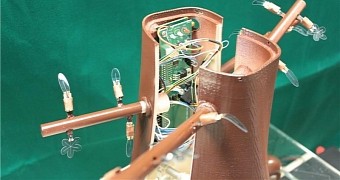Until now, most robots have been based on basic physics, or inspired by some sort of animal, or man himself, but plants have been curiously overlooked. Mostly because they don't actually move. This has now changed though.
We can't really fault the scientific community for not thinking about plant life much when designing the next robot or other type of moving machinery. After all, plants aren't known for moving under their own power.
Besides, the attention that robotic experts haven't shown plants was more than made up for by architects and landscape artists.
Now, though, Barbara Mazzolai of the Istituto Italiano di Tecnologia (IIT) has created the PLANTOID robot, or at least a prototype.
Funded via the Future and Emerging Technologies (FET) scheme, the robot is meant to show just how much can be learned from plants.
The Plantoid robot
The robot is basically a makeshift plant with two roots. One of the roots has sensors installed at the very tip and can pick up various signals.
The root can use those signals to know when to bend, like if it needs to get out of the way of a stumbling block of blast of toxic products.
The other root can artificially grow, by depositing layers of new material near the tip of the root, penetrating the soil. Basically, instead of mechanically drilling through the ground, it literally grows into it.
The Plantoid isn't supposed to be used for anything, since it's just a concept meant to show what can be done just by applying some of the traits of plants to our inventions.
However, Mazzolai does believe that space exploration, medicine and agriculture can benefit greatly from this heretofore unexplored field of robotics science.
Flexible endoscopic robots could be valuable assets in surgeries as well, while larger plants could aid in search and rescue. We are Groot?
How the robot acts as a single whole
It's all thanks to a micro-computer housed in the trunk connecting the two roots together. The trunk is made of plastic, but actual practical applications will likely employ more environment-friendly materials. There are even "branches" with "leaves" that sense the environment. All in a 3D printed "shell" apparently.
The Plantoid will gain extra functions by April 2015, by which point other plant structures should start being tested. No clue how long until they can power themselves off solar energy though. It is, however, quite ironic that plant-inspired robots have the potential to be equally intelligent and aware of their surrounding as those based on animals and our own anatomy.

 14 DAY TRIAL //
14 DAY TRIAL //